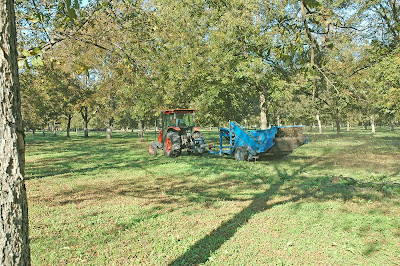After harvesting our Kanza crop, I noticed that the size if the nuts was far more variable than in previous years (photo at left). Nuts differed is size from larger than average to very small. For the purpose of taking a photo, I combed through a super sack of Kanzas to find pecans that would represent the kind of variation I was seeing. The majority of nuts were medium sized however I definitely noticed a sprinkling of small nuts in the sack.
To give you an idea of the variation in nut size I found I weighed the 8 nuts in the photo. The table below gives you my results. In looking over the numbers, its good to remember that our long term average for Kanza is 5.15 grams per nut. You can definitely see that I tried to pick out the extremes in nut size for the photo.
------------------------------
Kanza Nut Weights (g)
------------------------------
8.74 5.69
8.05 4.24
7.44 3.72
5.83 2.10
------------------------------
Over production not only effected nut size but influenced kernel fill. In cracking out Kanza nuts this year I found most nuts were plump and perfect as usual. But, I also found kernels the had hollow looking undersides. It became clear to me that this year's Kanza crop was suffering from over production. However, how our trees responded to the overproduction is fairly unique among pecan cultivars. In my experience, trees that bear too many nuts respond in one of two ways; They produce a tree full of small nuts or all the nuts have normal size but the kernels are poorly filled. Kanza seems to do a little of both, while still producing a majority of nuts with high quantity. However, I've learned a valuable lesson in 2016. Like most improved pecan cultivars, Kanza would benefit from mid summer tree shaking to reduce excessive nut production.



















































